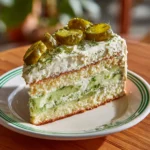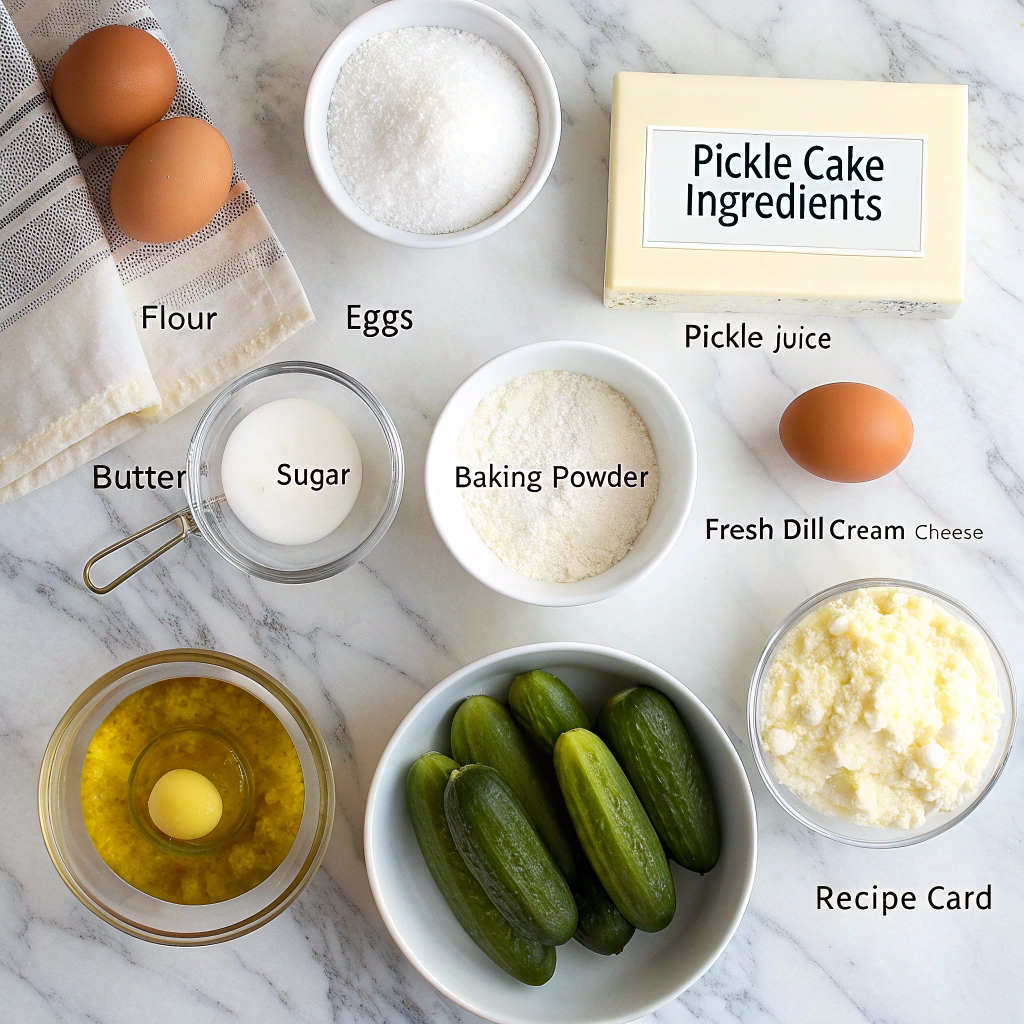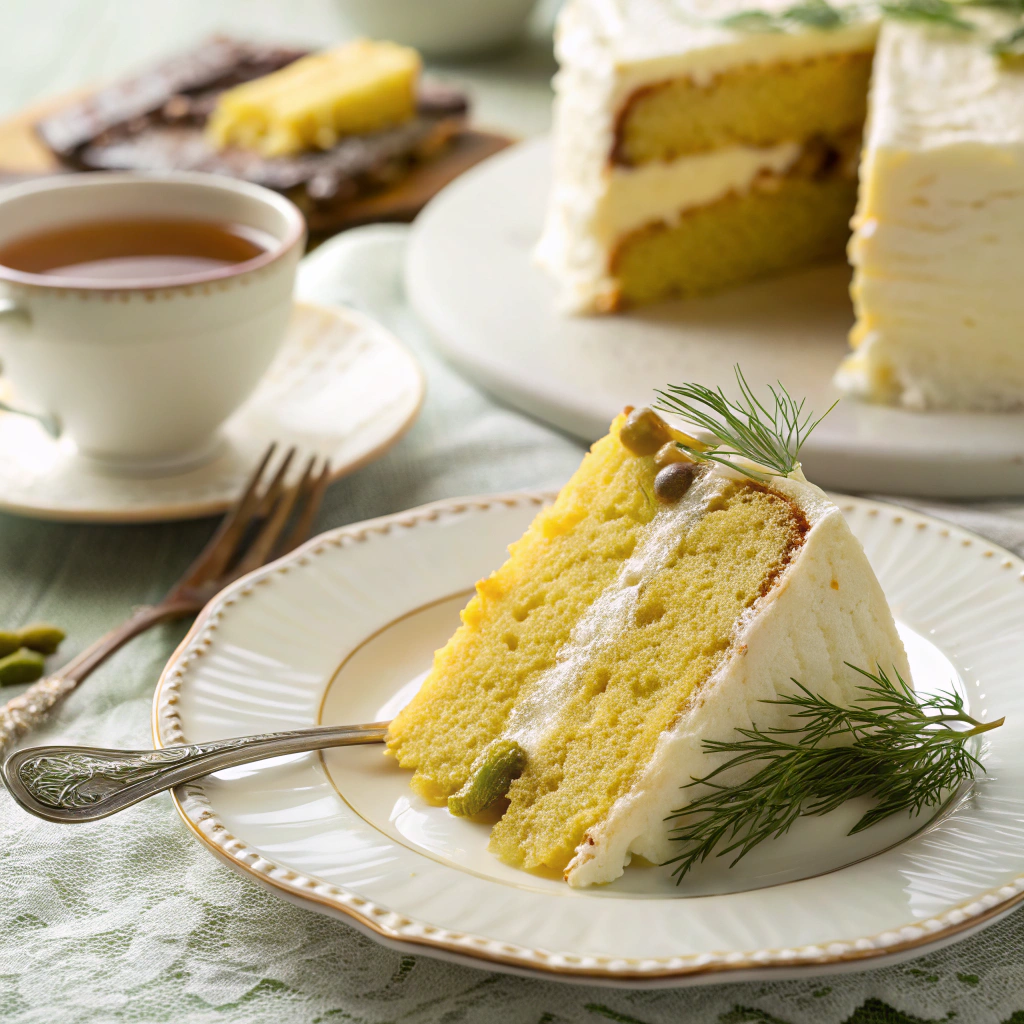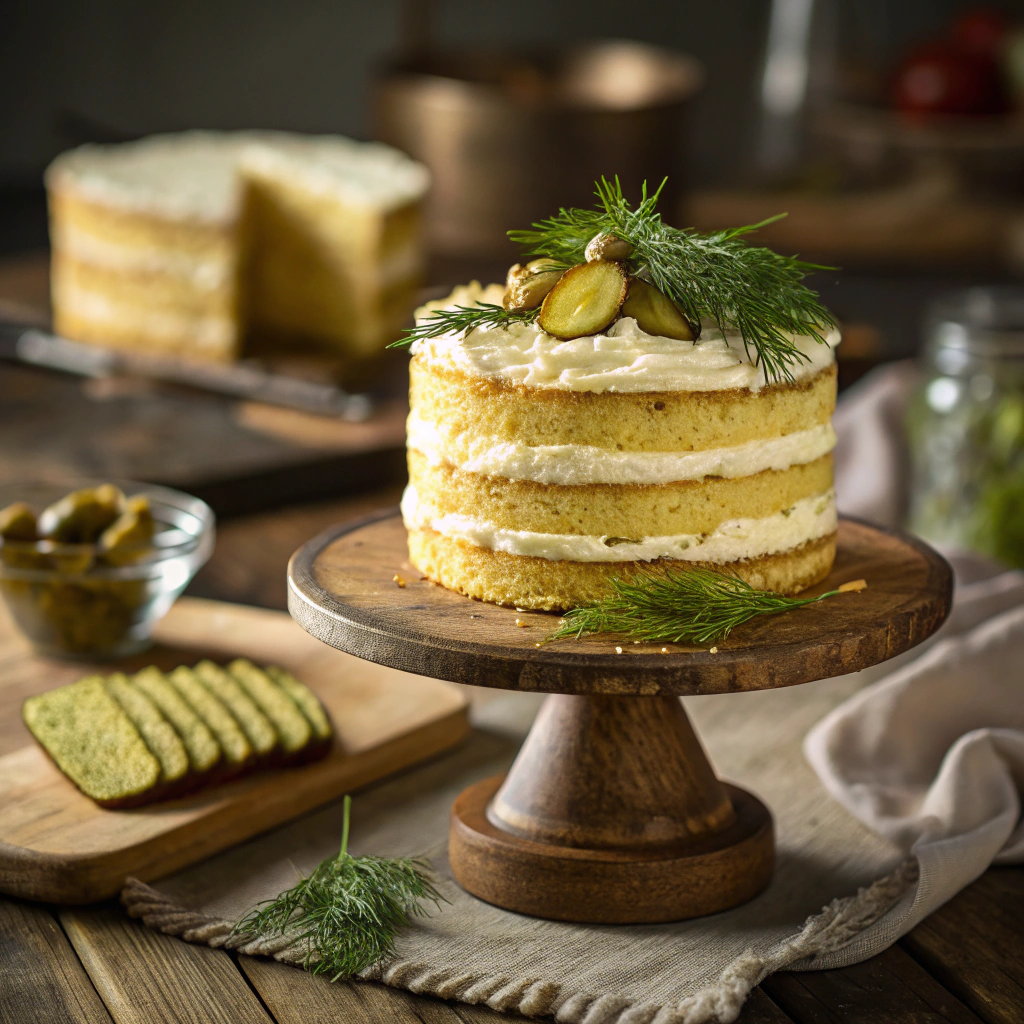What if we told you that pickle juice could create the most unexpectedly delicious pickle cake recipe you’ve ever tasted? This isn’t an internet prank – it’s a beloved regional dessert that’s been winning over skeptics for decades. Many people are curious about unique dessert recipes but hesitate to try unconventional ingredients like pickle juice in baking. Today, you’ll master this surprisingly delightful pickle cake recipe that perfectly balances sweet and tangy flavors, complete with foolproof instructions and expert tips that will have your guests asking for seconds .
Table of Contents

Easy Pickle Cake Recipe: Sweet & Tangy Dessert Guide
- Total Time: 45 minutes
- Yield: 8 servings 1x
- Diet: Vegetarian
Description
This Sweet & Tangy Pickle Cake is the ultimate adventure dessert that will surprise and delight your taste buds! Combining the sweetness of a classic cake with the unexpected tang of pickles, this moist and flavorful treat is perfect for adventurous eaters and anyone looking to try something completely unique. In just 45 minutes, you’ll have a conversation-starting dessert that’s equal parts sweet, tangy, and absolutely delicious.
Ingredients
- 1 ½ cups all-purpose flour
- 1 cup granulated sugar
- 1 teaspoon baking soda
- ½ teaspoon salt
- 1 cup pickle juice (from a jar of dill or sweet pickles)
- ½ cup vegetable oil
- 2 large eggs, room temperature
- 1 cup finely chopped pickles (dill or sweet, based on preference)
- 1 teaspoon vanilla extract
- Pickle slices for garnish (optional)
Instructions
- Prep Your Pan and Oven: Preheat oven to 350°F (175°C). Butter a 9-inch round cake pan and dust with flour, tapping out excess.
- Mix the Dry Foundation: In a large mixing bowl, whisk together flour, sugar, baking soda, and salt until well combined.
- Create the Pickle Magic: In a separate bowl, whisk together pickle juice, vegetable oil, and eggs until smooth and well blended. This pickle juice is your secret weapon for that amazing tangy flavor!
- Combine Wet and Dry: Pour the wet mixture into the dry ingredients and stir until just combined. Don’t overmix—a few lumps are perfectly fine.
- Fold in the Star Ingredient: Gently fold in chopped pickles and vanilla extract, ensuring pickles are evenly distributed throughout the batter for delicious tangy surprises in every bite.
- Bake to Golden Perfection: Pour batter into prepared pan and spread evenly. Bake for 30-35 minutes, or until a toothpick inserted in center comes out clean.
- Cool and Garnish: Let cake cool in pan for 10 minutes, then turn out onto a wire rack. For an eye-catching presentation, arrange thin pickle slices on top before serving.
Notes
Fresh, high-quality pickles make all the difference in flavor! Choose sweet pickles for a milder taste or dill for more tang. Chop pickles finely to ensure even distribution and prevent large chunks. Make sure your oven is properly preheated for the best rise and texture. This cake actually gets better the next day as flavors meld together!
- Prep Time: 15 minutes
- Cook Time: 30 minutes
- Category: Dessert
- Method: Baking
- Cuisine: American
Nutrition
- Serving Size: 1 slice (1/8th of cake)
- Calories: 250
- Sugar: 14g
- Sodium: 320mg
- Fat: 8g
- Saturated Fat: 1g
- Unsaturated Fat: 6g
- Trans Fat: 0g
- Carbohydrates: 42g
- Fiber: 1g
- Protein: 4g
- Cholesterol: 47mg
What is Pickle Cake? Understanding This Unique Dessert
Pickle cake represents one of America’s most intriguing regional desserts, originating in the Midwest where resourceful bakers discovered that pickle juice could transform ordinary cake batter into something extraordinary. This pickle cake recipe has roots dating back to the Great Depression era, when home cooks learned to waste nothing and found creative uses for every ingredient in their kitchens.
Origins and Cultural Significance
The tradition of using pickle juice in baking emerged from German-American communities in Pennsylvania and Ohio, where fermented foods played a central role in daily meals. These resourceful bakers recognized that the acidic properties of pickle brine could enhance both flavor and texture in desserts. The fermented food benefits found in pickle juice contribute natural probiotics and complex flavors that elevate this humble cake to gourmet status.
Flavor Profile Explanation
Contrary to what many expect, a well-made pickle cake doesn’t taste overwhelmingly of pickles. Instead, the pickle juice provides a subtle tang that enhances the cake’s sweetness, creating a complex flavor profile reminiscent of lemon cake with deeper, more sophisticated notes. The acidity brightens the overall taste while the salt content from the brine balances the sugar, resulting in a perfectly harmonious dessert.
Why Pickle Juice Works in Baking
The science behind this pickle cake recipe lies in the acidic nature of pickle juice, which reacts with baking soda to create lift and tenderness. The vinegar content tenderizes gluten strands, resulting in an incredibly moist cake texture that stays fresh longer than traditional recipes. Additionally, the salt enhances flavor perception while the natural preservatives help extend the cake’s shelf life.
Essential Ingredients for Perfect Pickle Cake Recipe
Creating the perfect pickle cake recipe requires careful attention to ingredient selection and proportions. Each component plays a crucial role in achieving the ideal balance of sweet and tangy flavors while maintaining the moist, tender texture that makes this dessert so memorable.
Core Ingredients Breakdown
For the Cake:
- 2 cups (240g) all-purpose flour
- 1¾ cups (350g) granulated sugar
- 3 large eggs, room temperature
- ½ cup (115g) unsalted butter, softened
- ½ cup (120ml) dill pickle juice
- ½ cup (120ml) whole milk
- 1½ teaspoons baking powder
- ½ teaspoon baking soda
- ½ teaspoon salt
- 1 teaspoon vanilla extract

Pickle Juice Selection Guide
The type of pickle juice you choose dramatically impacts your pickle cake recipe results. Dill pickle juice provides the classic tangy flavor most associated with this dessert, while sweet pickle juice creates a mellower, more dessert-appropriate taste. Avoid using pickle juice from spicy or heavily seasoned varieties, as these can overpower the cake’s delicate balance. Always strain the juice to remove any pickle pieces or herb fragments that might affect the cake’s texture.
Ingredient Substitutions and Alternatives
For those following specific dietary requirements, several substitutions work well in this pickle cake recipe:
- Gluten-free flour: Replace all-purpose flour with a 1:1 gluten-free baking blend
- Dairy-free milk: Substitute with unsweetened almond or oat milk
- Vegan butter: Use plant-based butter alternatives in equal proportions
- Egg substitutes: Replace each egg with ¼ cup unsweetened applesauce or commercial egg replacer
Step-by-Step Pickle Cake Recipe Instructions
Follow these detailed instructions to create your perfect pickle cake recipe with professional-quality results every time.
Preparation and Mixing Techniques
- Pre-heat and prepare: Set your oven to 350°F (175°C). Grease two 9-inch round cake pans and dust with flour, tapping out excess.
- Cream butter and sugar: In a large mixing bowl, cream softened butter and granulated sugar until light and fluffy, approximately 3-4 minutes with an electric mixer.
- Add eggs gradually: Incorporate eggs one at a time, beating well after each addition to ensure proper emulsion.
- Combine dry ingredients: In a separate bowl, whisk together flour, baking powder, baking soda, and salt.
- Mix liquid components: Combine pickle juice, milk, and vanilla extract in a measuring cup.
- Alternate additions: Add dry ingredients and liquid mixture to the creamed butter alternately, beginning and ending with flour mixture. Mix until just combined – overmixing creates tough cake texture.
Baking Temperature and Timing
Divide batter evenly between prepared pans, using a kitchen scale for precision if available. Bake for 25-30 minutes, rotating pans halfway through for even browning. The pickle cake recipe requires careful attention during baking, as the acidic ingredients can cause faster browning than traditional cakes.
Testing for Doneness
Your pickle cake is perfectly baked when a toothpick inserted in the center comes out with just a few moist crumbs attached. The cake should spring back lightly when touched in the center, and the edges should just begin pulling away from the pan sides. Allow cakes to cool in pans for 10 minutes before turning out onto wire racks to cool completely.
Cream Cheese Frosting and Finishing Touches
The ideal complement to any pickle cake recipe is classic cream cheese frosting, which enhances the tangy elements while adding rich, creamy sweetness.
Classic Cream Cheese Frosting Recipe
Ingredients:
- 8 oz (225g) cream cheese, softened
- ½ cup (115g) unsalted butter, softened
- 4 cups (480g) powdered sugar, sifted
- 1 teaspoon vanilla extract
- 2-3 tablespoons heavy cream (as needed)
Beat cream cheese and butter until smooth and fluffy. Gradually add powdered sugar, beating until well combined. Add vanilla and enough cream to achieve spreadable consistency. This frosting perfectly balances the pickle cake’s unique flavors while providing traditional dessert appeal.
Garnishing Options with Dill and Pickles
Elevate your pickle cake recipe presentation with creative garnishes. Fresh dill sprigs add visual appeal and hint at the cake’s unique ingredient, while paper-thin pickle slices arranged decoratively around the cake’s base create conversation-starting presentation. Avoid using too many pickle elements – subtlety ensures broad appeal.
Presentation and Serving Suggestions
Serve your pickle cake at room temperature for optimal flavor development. Consider pairing with unique beverage pairings like herbal teas or sparkling lemonade that complement the tangy-sweet profile. Present on a simple white cake stand to let the cake’s golden color shine, and consider offering small portions initially to allow skeptical guests to sample this unique dessert.
Troubleshooting Common Pickle Cake Problems
Even with careful attention to detail, pickle cake recipe challenges can arise. Understanding common issues and their solutions ensures consistent success with this unique dessert.
Texture Issues and Solutions
Dense, heavy texture typically results from overmixing the batter or using too much flour. Measure flour by spooning into the measuring cup and leveling, never by scooping directly from the bag. If your cake turns out too moist, ensure you’re using the correct pickle juice amount and that your oven temperature is accurate – acidic ingredients can affect baking times.
Flavor Balance Adjustments
If your pickle cake recipe tastes too tangy, increase the vanilla extract slightly in future batches or ensure you’re using dill pickle juice rather than more acidic varieties. Conversely, if the pickle flavor is too subtle, strain and reserve additional pickle juice to brush lightly on cake layers before frosting.
Storage and Freshness Tips
Pickle cake stays remarkably moist due to the acidic ingredients, but proper storage maximizes freshness. Store unfrosted cake wrapped tightly at room temperature for up to 3 days, or refrigerate frosted cake covered for up to 1 week. The flavors actually improve after 24 hours, making this an excellent make-ahead dessert for entertaining.
Recipe Variations and Dietary Modifications
Adapting this pickle cake recipe for various dietary needs ensures everyone can enjoy this unique dessert’s distinctive flavors.
Gluten-Free Pickle Cake Options
Success with gluten-free versions requires using a quality 1:1 baking flour blend that contains xanthan gum. Increase mixing time slightly to develop structure, and expect a slightly denser texture than traditional versions. Some bakers add an extra ¼ teaspoon of baking powder to compensate for gluten-free flour’s reduced lift capacity.
Vegan Modifications
Creating a vegan pickle cake recipe involves substituting plant-based butter, non-dairy milk, and commercial egg replacer or applesauce. The acidic pickle juice actually helps bind these alternative ingredients, often resulting in surprisingly successful vegan versions. Use aquafaba (chickpea liquid) as an egg substitute for best results, using 3 tablespoons per egg.
Different Pickle Types and Flavors
Experiment with various pickle juices to create unique flavor profiles. Sweet pickle juice produces a more dessert-like cake, while kosher dill provides classic tangy notes. Bread and butter pickle juice offers a balanced sweet-tart flavor that appeals to uncertain palates. Always taste your chosen pickle juice first to ensure it complements rather than overwhelms the cake’s sweetness.

Frequently Asked Questions
Does pickle cake recipe actually taste like pickles?
No, a well-made pickle cake doesn’t taste strongly of pickles. The pickle juice provides a subtle tangy note that enhances the cake’s sweetness, creating a flavor profile similar to lemon cake but with more complex, sophisticated undertones. The tang is noticeable but pleasant, complementing rather than overpowering the dessert qualities.
Can I use any type of pickle juice for this pickle cake recipe?
While you can experiment with different types, dill pickle juice produces the classic flavor most associated with traditional pickle cake. Sweet pickle juice creates a milder taste that some prefer, while kosher dill provides a clean, straightforward tang. Avoid heavily spiced or flavored pickle juices that might create conflicting flavors in your finished cake.
How long does homemade pickle cake stay fresh?
Pickle cake stays remarkably fresh due to the natural preservative qualities of the acidic ingredients. Unfrosted cake keeps at room temperature for 3-4 days when properly wrapped, while frosted cake should be refrigerated and consumed within one week. The flavors actually improve after 24 hours, making it an excellent make-ahead dessert option.
What frosting works best with pickle cake recipe?
Classic cream cheese frosting is the traditional and most recommended choice, as its tangy richness complements the cake’s unique flavor profile perfectly. The slight tang in cream cheese frosting enhances rather than competes with the pickle cake’s distinctive taste. Buttercream frosting also works well for those preferring sweeter options.
Can I make pickle cake without eggs for dietary restrictions?
Yes, this pickle cake recipe adapts well to egg-free versions. Substitute each egg with ¼ cup unsweetened applesauce, 3 tablespoons of aquafaba (chickpea liquid), or commercial egg replacer following package directions. The acidic pickle juice actually helps bind alternative ingredients, often producing surprisingly successful egg-free results.
Is pickle cake suitable for special occasions and parties?
Absolutely! Pickle cake makes an excellent conversation starter at parties and special events. Its unique flavor surprises guests pleasantly, and the cake’s attractive golden color and professional appearance when properly frosted make it suitable for any gathering. Consider offering small portions initially to encourage hesitant guests to try this distinctive dessert.
This remarkable pickle cake recipe proves that the most unexpected ingredient combinations often create the most memorable desserts. The perfect balance of sweet and tangy flavors, combined with incredible moisture and keeping qualities, makes this cake a worthy addition to any baker’s repertoire. Whether you’re looking to surprise guests at your next gathering or simply want to explore unique flavors, this pickle cake delivers both novelty and genuine deliciousness. Don’t let the unusual main ingredient deter you – countless converts can attest to this cake’s surprising appeal. Consider pairing your slice with coffee pairing ideas for an elevated dessert experience. Try this recipe today and discover why pickle cake has earned its place among America’s most beloved regional desserts.

